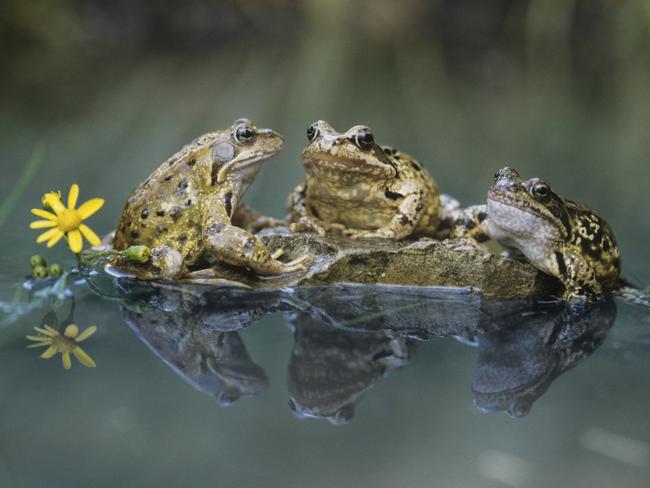Angela Mollard: The best friends are those who don’t fit a template
SORRY boys. Female friendships aren’t like male friendships. They can be confusing, dangerous - and extremely rewarding.

LAST week I went out for dinner with people I didn’t know but hoped would like me.
As I got dressed, I texted a friend, because while I may have duped you into thinking I’m wise and confident, there are moments when I’m as wracked with insecurity as the next 14-year-old.
“I’m thinking leopard print,” I messaged my friend.
“Might be a little loud, slapper,” she messaged back.
“Pink?” “Mmm, a bit tryhard.” “Blue,” I replied. “If I drop food down myself no one will notice.” “You know what, Ange,” she replied. “Most people want to like others. Therefore, you don’t have to be anything other than who you are.”
Where do they come from, these friends who bob in the ocean of your life as reliably as little red buoys? Who, as the years pass and you both become more barnacle-ridden and seaweed-strewn, seem to speak not in the gushing platitudes of youth, but with such shiny pearls of wisdom you want to string them around your heart.

Of all the delights of middle age, chief among them has to be friendship (frankly, there has to be something to compensate for early-onset Alzheimer’s and a softening waistline). Gone is the frantic competitiveness and constant comparing of youth, and in its place is an acceptance that we’re all stumbling along the same Joy and Suffering Index (JSI). My dearest friendship has just racked up its 20th year and, trust me, our respective profiles on the JSI are neither linear nor pleasingly parabolic, but the crazed jags of the dramatic and demented.
“We may not be rich,” Sarah says as we lament for the 400 millionth time that we did not marry bankers, “but in favourable light, and after a good sleep, at least we are interesting.”
The best thing about old friends is not that they love you or trust you or that they’ll make up the couch in desperate moments, but that they know you. Sarah knows I’ll be picking the inside of my left thumb nail if I’m stressed; that I can source in four seconds the best muesli in any supermarket; that I might have called my daughter Calypso had she not been so chortlingly rude about it (and that her son might have been Galen had I not done my best Planet of the Apes impersonation); that I’m hopeless with birthdays but OK in random moments of need; that I’m prone to disastrous haircuts after major life events; and that I was truly mortified when, having driven my car into the back bumper of a disabled priest, I sat indignantly wondering why he didn’t get out of his vehicle. Oh, and she knows I was right to give up on the tight-fisted Goldman Sachs banker because she dated him too — just to be sure.

In return, I know she counts a Bloody Mary as two serves of vegetables and that she wears industrial-strength earmuffs when her children are being particularly testing.
I don’t want to be patronising, but I fear many men don’t have sustaining friendships like this. That because their life is calibrated to their workplaces, any collegiality is anchored in what they do, not who they are. Their social lives are often run by their wives, and the hobbies of their youths have given way to the under-acknowledged burden of providing and being a decent dad. It’s a shame, because as Brendan Cowell suggests in his novel How It Feels, it’s not talking but shared experiences — or simply proximity — that binds men.
You’d think that with social media oiling the pathway to new (and preloved) playmates, we’d all be overrun with friends. But new research suggests that almost half of us (45%) have fewer friends than we’d like. Furthermore, Intrepid Travel, which seems to advocate a little jaunt through the Andes as an excellent way of boosting your contacts list, found that while 55% have one to three close friends, half of us agree the ideal number is four to six.
While friend tabulation sounds like the sort of self-obsessed practice that might cause you to lose a few, I can thoroughly recommend being open to new buddies — not least because by my age you’ll have fallen victim to “friend-frogging”, where one friend leapfrogs you and becomes besties with one of your others (note no bitterness).

Two years ago, I went trekking in Nepal and came home with giardia and a new chum called Sally. “What are you feeding that thing?” she said, indicating a spot on my chin that was clearly embracing the mountain theme. The pimple and the giardia duly departed, but I’m still trying to get rid of Sal.
In closing, some friendship advice for my daughters: Don’t be overprescriptive in your requirements. The best friends are those who don’t fit a template; bitchiness is a myth you can personally dismantle; don’t be suspicious of those with no girlfriends, but make it your personal mission to befriend them; listen, don’t solve; lend your shoes; don’t agree with her if she’s wrong; celebrate her victories, not just your own; don’t leave it til the end to tell your friends how precious they are.
“You have been my friend,” said Charlotte to Wilbur in the final pages of Charlotte’s Web. “That in itself is a tremendous thing.”



